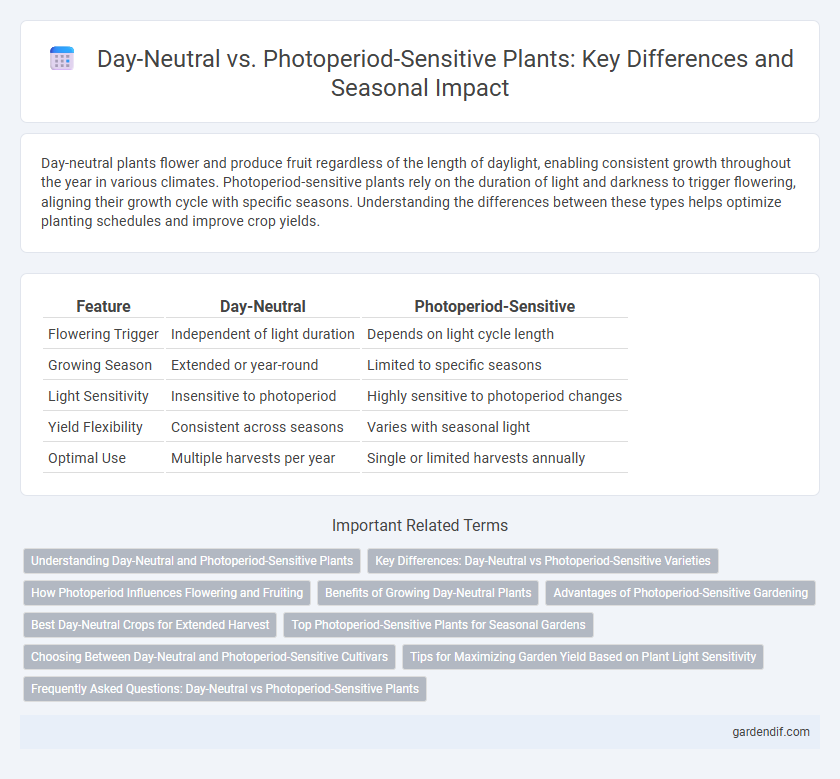
Day-neutral vs Photoperiod-sensitive Illustration
Day-neutral plants flower and produce fruit regardless of the length of daylight, enabling consistent growth throughout the year in various climates. Photoperiod-sensitive plants rely on the duration of light and darkness to trigger flowering, aligning their growth cycle with specific seasons. Understanding the differences between these types helps optimize planting schedules and improve crop yields.
Table of Comparison
| Feature | Day-Neutral | Photoperiod-Sensitive |
|---|---|---|
| Flowering Trigger | Independent of light duration | Depends on light cycle length |
| Growing Season | Extended or year-round | Limited to specific seasons |
| Light Sensitivity | Insensitive to photoperiod | Highly sensitive to photoperiod changes |
| Yield Flexibility | Consistent across seasons | Varies with seasonal light |
| Optimal Use | Multiple harvests per year | Single or limited harvests annually |
Understanding Day-Neutral and Photoperiod-Sensitive Plants
Day-neutral plants flower regardless of the length of day or night, making them ideal for regions with inconsistent seasonal light patterns. Photoperiod-sensitive plants rely on specific light durations to trigger flowering, classified as either short-day or long-day species depending on their flowering response to day length. Understanding these photoperiodic responses is crucial for optimizing growth cycles in agriculture and horticulture.
Key Differences: Day-Neutral vs Photoperiod-Sensitive Varieties
Day-neutral plants flower regardless of the light duration, offering continuous production throughout the growing season, while photoperiod-sensitive varieties bloom only when exposed to specific light cycles, typically short or long days. Day-neutral varieties, such as tomatoes and cannabis strains labeled as auto-flowering, provide more flexibility for multiple harvests and varying geographic locations. Photoperiod-sensitive plants depend on natural seasonal cues, making them ideal for growers targeting specific harvest times tied to sunrise and sunset durations.
How Photoperiod Influences Flowering and Fruiting
Photoperiod-sensitive plants rely on the length of day and night to trigger flowering and fruiting, with short-day plants flowering when nights exceed a critical duration and long-day plants flowering when nights are shorter. This sensitivity ensures reproductive phases align with optimal environmental conditions, enhancing survival and yield. In contrast, day-neutral plants flower independently of day length, responding primarily to maturity or other factors, making them versatile across varying seasons.
Benefits of Growing Day-Neutral Plants
Day-neutral plants offer consistent flowering regardless of day length, enabling multiple harvests throughout the growing season. This trait increases crop yield and allows for flexible planting schedules, ideal for regions with unpredictable light cycles. Their adaptability to varying photoperiods reduces dependency on specific seasonal conditions, enhancing agricultural productivity.
Advantages of Photoperiod-Sensitive Gardening
Photoperiod-sensitive gardening offers precise control over plant flowering times by responding to natural daylight cycles, ensuring optimal growth stages aligned with seasonal changes. This approach conserves energy by eliminating the need for artificial lighting, reducing environmental impact and operational costs. Gardeners benefit from higher yields and improved plant quality due to synchronization with the plant's innate biological rhythms.
Best Day-Neutral Crops for Extended Harvest
Day-neutral crops, such as tomatoes, strawberries, and cucumbers, thrive regardless of daylight length, making them ideal for extended harvest periods. Photoperiod-sensitive plants rely on specific day lengths to trigger flowering, limiting their growing season. Selecting day-neutral varieties allows gardeners to maximize yield throughout multiple seasons without interruption.
Top Photoperiod-Sensitive Plants for Seasonal Gardens
Photoperiod-sensitive plants, such as chrysanthemums, poinsettias, and soybeans, rely on the length of daylight to trigger flowering, making them ideal for seasonal garden planning. These species respond to specific photoperiods by initiating growth stages, which allows gardeners to predict and control bloom times based on seasonal light changes. Understanding the photoperiodic response is essential for optimizing flower production and maximizing seasonal garden aesthetics.
Choosing Between Day-Neutral and Photoperiod-Sensitive Cultivars
Day-neutral cultivars bloom regardless of daylight length, making them ideal for continuous or multiple harvests throughout the growing season. Photoperiod-sensitive cultivars rely on specific light durations to trigger flowering, which suits growers targeting seasonal cycles or distinct harvest periods. Selecting between them depends on climate conditions, desired harvest timing, and growing space limitations.
Tips for Maximizing Garden Yield Based on Plant Light Sensitivity
Day-neutral plants bloom regardless of light duration, allowing continuous harvests throughout the growing season, while photoperiod-sensitive plants require specific light cycles to trigger flowering, making timing crucial for garden planning. To maximize yield, maintain consistent daily light exposure for day-neutral varieties and carefully adjust planting schedules to align with natural photoperiods for sensitive species. Monitoring local daylight patterns and using supplemental lighting or shading techniques can optimize flowering and fruiting phases, boosting overall garden productivity.
Frequently Asked Questions: Day-Neutral vs Photoperiod-Sensitive Plants
Day-neutral plants flower regardless of the length of daylight, making them ideal for continuous harvest cycles, while photoperiod-sensitive plants require specific light durations to initiate flowering, often influenced by seasonal changes. Gardeners frequently ask if day-neutral varieties yield consistently throughout the year, to which the answer is yes, as their flowering depends on age rather than light exposure. Photoperiod-sensitive plants, commonly grown in controlled environments, respond to changes in light duration, enabling precise timing of flowering for seasonal crops like chrysanthemums and cannabis.
Day-neutral vs Photoperiod-sensitive Infographic

 gardendif.com
gardendif.com